Lt Col Weggery
LIEUTENANT COLONEL LAWRENCE WEGGERY
Spitfire pilot and Salvation Army Officer
Download this article (PDF 1.1MB)
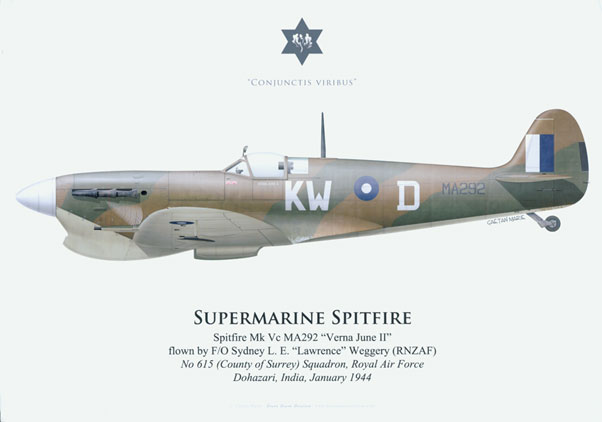
Sydney Lawrence Emil Weggery was born in Lower Hutt on 8 December 1920. At the age of 18 he experienced two profound and life changing events. He was led by personal conviction of his need of a Saviour and, directed by his reading of the Bible, he entered an experience of Salvation. At the same age he watched as the world descended into the international conflict known as World War Two. He would fight battles in both contexts.
Lawrence testified that, ‘after the first flood of the Holy Spirit had passed away, temptations continued to spring from within, opposing his desire for spiritual things.’ At the same time the prospect of military service proved very distracting. ‘Like many young New Zealanders, at the age of 18, when war was declared in 1939 I wanted to be involved in this great adventure.’ His parents eventually agreed to sign the papers to allow him to enlist in June 1940.
His enthusiasm for adventure was soon tempered by the realities that often surround it. ‘At one stage I recall seeing a newspaper billboard at Wellington Railway station about ‘Cobber’ Kain[1] and his exploits in France. To us kids, 18 and 19 years old, he was the ace pilot. However, the day after I enlisted I stepped out onto Wellington Railway station to read that ‘Cobber’ Kain had been killed. That rather shook us – to realise that this was something serious we were getting involved in.’
After passing through the New Zealand Air Crew training system Lawrence started his flying career as a Flying Officer flying Harvards in Canada. While waiting for an operational posting in England he volunteered to serve in India against the Japanese. ‘Anywhere that was warmer and had more food than England sounded good!’ Initially flying Hurricanes, Lawrence had his first experience of flying the Spitfire on 11 October 1943. It immediately made an impression. ‘I enjoyed a smooth powerful takeoff, much more ‘kick in the back’ than the old Hurricane.’
The Spitfire proved a beautiful plane to fly. Taxiing, however, could be a bit tricky. ‘There were numerous taxiing accidents with the Spitfires, particularly when we first received them. One reason was that the minimum taxi speed was 40 mph, to achieve enough cooling flow through the radiator and at the same time we would be weaving so as to see past the long nose. As you can imagine, on a dusty air strip with a number of aircraft taxiing a huge amount of dust was thrown up. Aircraft would touch wing-tips and spin around on their narrow undercarriage.’ The two Spitfires that Lawrence flew were both named ‘Verna June’, not after a sweetheart as many thought but named after his sister Verna. In November 1943 he was involved in the first Spitfire victory over East Bengal. 615 Squadron operated intensively in support of Allied ground forces; from intercepting raids and ground attacks to escorting supply drops to troops on the ground. Lawrence’s log book records eleven sorties on 26 & 27 April 1944 alone.
It was while flying Verna June that he was given the nickname ‘One Leg Weg’. During a take-off one of his tyres went flying past him; he radioed the base explaining his predicament and by the time he had lined himself up to land the fire trucks and ambulance were waiting for him, all expecting the worst upon landing. However, he was able to hold her steady and land on one wheel. From then on, to the ground crew he was known as ‘One Leg Weg’!
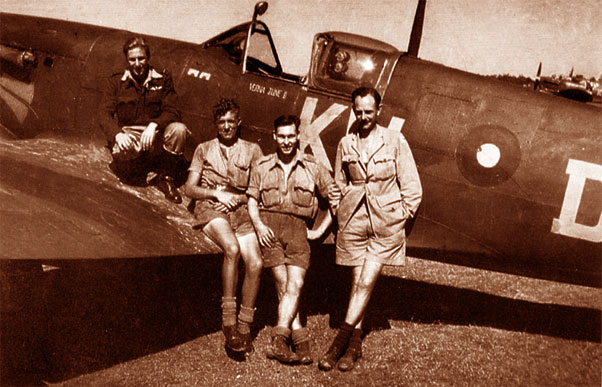
Flying Officer Lawrence Weggery (far left) with the ground crew of ‘Verna June’ January 1944.
Disease, one of the many risks in wartime, caught up with Lawrence while he was stationed at a new temporary base called Jorhat. He and 14 others were forced to sleep in the back of their truck without mosquito netting when they were delayed by road works. Lawrence was hospitalised on 19 May 1944 with malaria and, as if that wasn’t enough, also suffered peritonitis while convalescing at the 47th British Military Hospital in Calcutta. By the time he had recovered and returned to 615 Squadron on 4 October of the same year they were enjoying a well-earned rest at Baigachi. He never flew operationally again.
As a teenager, at Hutt Valley High School, Lawrence had learned to play the cornet in the school brass band. While taking a couple of days leave in Calcutta in 1943 he was invited to join a serviceman’s band run by The Salvation Army. The Salvation Army became his spiritual home and his reading of Samuel Logan Brengle’s ‘Helps to Holiness’ revealed to him his need and the power that could be his through living a life of holiness. From then on he gave his life wholly to God and the Holy Spirit brought completeness in his life, which helped him to overcome the temptations he met on a day to day basis.
It was in Calcutta that he met Enid, the daughter of Danish Salvation Army Officers on missionary service in India. Naturally the couple would be concerned for each other’s safety and Lawrence’s job carried a fair bit of risk! In the days before cell phones and text messages people were perfectly capable of innovative communication and Lawrence was no exception. On his return from a sortie he would ‘buzz’ Enid’s place of work with a low flyover and wing dip to let her know that he had returned safely. Each flyover must have been of great comfort to Enid although she had to be discreet about the pilot’s identity. Her employer was often heard to exclaim about the irresponsibility of some of the young air force pilots when he saw this happening!
By late 1944, when he had recovered from his malaria and peritonitis, doctors advised that he would never really be free of malaria until he returned to a cooler climate. At about the same time he also learned of the New Zealand Government offer that any serviceman with three years overseas service could apply for repatriation and that any married man could bring his wife with him at no extra cost. Even though she was only 18 at the time, Enid’s parents agreed to the couple marrying. They married and honeymooned in Darjeeling; then travelled south to Calcutta and eventually to New Zealand arriving on 1 April 1945. The couple immediately applied, and were accepted for, training as Salvation Army Officers. As part of the ‘Fearless’ Session they entered training on 4 August 1945. An excerpt from the Training Principal’s final report could be seen as the hallmark of Lawrence’s service as a Salvation Army Officer, ‘Platform work effective, personal contacts show love for souls, evangelical, conscious of a definite call [from God] to officership.’
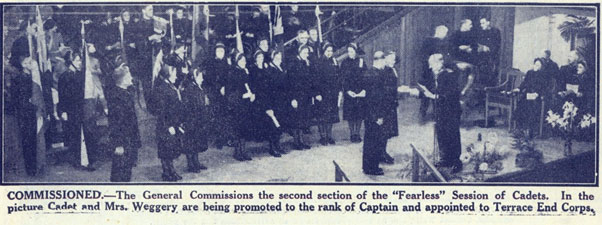
The Salvation Army War Cry, 9 February, 1946.
Following their commissioning as Salvation Army Officers on 7 February 1946, Lawrence and Enid were appointed to Terrace End Corps (Palmerston North). There followed a number of corps appointments including Newton, Christchurch City and Wellington City. Lawrence was appointed to welfare work at Linton Military Camp in 1950 and during his appointment to Palmerston North Corps he over sighted chaplaincy to Linton Camp. He was appointed a Military Chaplain in 1958.
In 1964 Lawrence was appointed to the Public Relations Department as Secretary for Broadcasting and Publicity (including Television) and he and Enid made a number of television appearances. Lawrence was a skilled communicator and a great presenter. One Salvation Army officer remembers him as ‘masterful on the platform at Christchurch City [corps]’. Another recalls that ‘at Wellington City [corps] Weg would get a big crowd in the gallery (as well as a full hall below) on Sunday nights.’
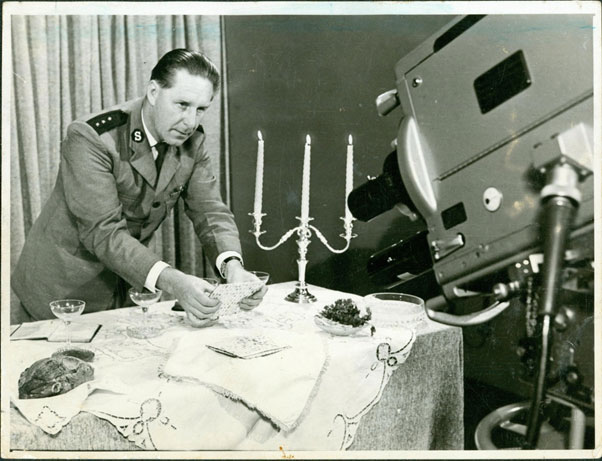
Major Lawrence Weggery presenting the Passover on Television.
In 1973 the couple were appointed to leadership of the Southern Division and in 1976 they transferred to Hong Kong where Lawrence took up the position of Officer Commanding, Hong Kong Command. They returned to New Zealand and to Divisional leadership in 1980 and took up appointments in the Wellington Division; Lawrence as Divisional Commander and Enid as Divisional Director Woman’s Organisations and Divisional Home League Secretary.
As a Divisional Commander, Lawrence was noted for using his caravan to help Enid and himself make regular visits to corps around the division. One Salvation Army officer couple writes of ‘fond memories of the Weggery’s’ who would arrive in the Nelson area ‘with their caravan and visit each of the officers in the ‘Top of the South’ with the officer’s fellowship[2] held in a bach at Kaiteretere Beach. To Lawrence’s credit he was not always one to be bound by the more restrictive elements of organisational culture. Perhaps his approach owes something to his earlier days as an air force pilot (these gentlemen not being known for their strict adherence to the rules). That is pure speculation but it is at least arguable that his approach contributed to his worth as a Divisional Commander. Another officer writes ‘He was a great DC. In Dunedin at Officers Councils[3], he said that he’d heard that officers were anxious about what might be written about them on their career cards. He produced a bundle of cards and handed each officer their career card saying ‘Here you are, read for yourselves!’
Lawrence’s approach to leadership was both balanced and intentional. When it was time to relax he would and he ensured that he made time to do the things he enjoyed. When it was time to do something it was done. He had two sayings recalled by a Salvation Army officer, one being that the best form of management is ‘MBWA’ (management by walking around) and ‘it's not what you expect but what you inspect that gets done.' It seems clear that Lawrence had an active interest in people and progress.
It was from his appointment as Territorial Property Secretary that he entered retirement on 1 January 1986 having given 39 years of active officer service. In December 1999 Lt Colonel Lawrence Weggery was recognised for his wartime services at a presentation at THQ in Pollard Hall.
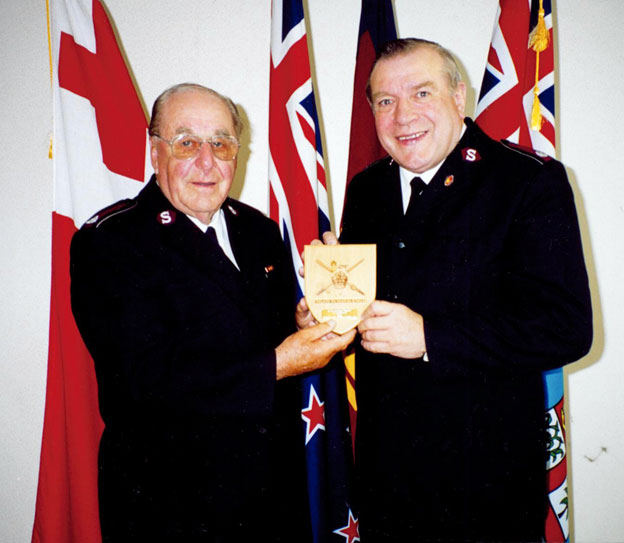
Lt Colonel Lawrence Weggery receiving his award from Lt Colonel Peter Savage in Pollard Hall, Territorial Headquarters, December 1999.
On Thursday 11 May 2006 Lieutenant Colonel Lawrence Weggery was promoted to Glory (passed away) at Wellington Hospital. The final comments from the Salvation Army bulletin read ‘Our thoughts and prayers are with his wife Lt Colonel Enid, son Lyndon, daughters Ingrid and Major Astrid and extended members of the family. Well done good and faithful servant!’ Perhaps it is fitting to conclude by reference to the last verse and chorus of a favourite song of Lawrence’s that he would often use during the Sunday night meetings.
Kingdom of Christ, for thy coming we pray,
Hasten, O Father, the dawn of the day
When this new song Thy creation shall sing,
Satan is vanquished and Jesus is King.
Come let us sing: Praise to our King,
Jesus our King, Jesus our King:
This is our song, who to Jesus belong:
Glory to Jesus, to Jesus our King.[4]
Sources:
Commissioner Garth McKenzie, Bulletin – New Zealand Fiji and Tonga Territory, The Salvation Army, 12 May 2006.
Malcolm Laird and Steve Mackenzie, Spitfire - The ANZACs: The RAF through Colonial Eyes, Ventura Publications 1997.
Heritage Centre & Archives, New Zealand Fiji and Tonga Territory, The Salvation Army – supplementary archival records.
The recollections of family and Salvationist colleagues.
Notes:
[1] Edgar James Kain DFC was a New Zealand fighter pilot who flew in the Royal Air Force during the Second World War.
[2] Conference for Salvation Army officers.
[3] Meeting for Salvation Army officers.
[4] Song 166, The Song Book of the Salvation Army (1987).